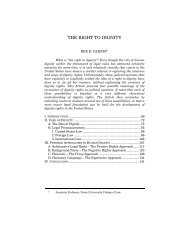A Right to Media? Lorie M. Graham - Columbia Law School
A Right to Media? Lorie M. Graham - Columbia Law School
A Right to Media? Lorie M. Graham - Columbia Law School
You also want an ePaper? Increase the reach of your titles
YUMPU automatically turns print PDFs into web optimized ePapers that Google loves.
2010] A RIGHT TO MEDIA? 447<br />
Committee on Economic, Social, and Cultural <strong>Right</strong>s, the protection<br />
of the moral and material interests of an individual or a group’s<br />
scientific, literary, and artistic productions depends in part on the<br />
accessibility of information, which includes:<br />
the right <strong>to</strong> seek, receive and impart information on the<br />
structure and functioning of the legal or policy regime <strong>to</strong><br />
protect the moral and material interests of authors<br />
resulting from their scientific, literary and artistic<br />
productions, including information on relevant legislation<br />
and procedures. Such information should be<br />
understandable <strong>to</strong> everyone and should be published also in<br />
the languages of linguistic minorities and indigenous<br />
peoples. 64<br />
Because it reaches a large number of people, media is an<br />
important component of this accessibility. However, the right <strong>to</strong> take<br />
part in cultural life is often undermined through the “deprivation of<br />
information <strong>to</strong> members or <strong>to</strong> groups in a society, the non-existence of<br />
a free-flow of information, a one-way communication situation, [and]<br />
monopolies of information or communications (whether by<br />
governments or private companies) . . . . ” 65<br />
Directly referencing media, Article 13 of the Children’s<br />
Convention (CRC) calls for the child’s right <strong>to</strong> freedom of expression<br />
and states that “this right shall include freedom <strong>to</strong> seek, receive and<br />
impart information and ideas of all kinds, regardless of frontiers,<br />
either orally, in writing or in print, in the form of art, or through any<br />
other media of the child’s choice.” 66 Additionally, the CRC explicitly<br />
directs states <strong>to</strong> “recognize the important function performed by the<br />
mass media.” 67 Expanding on the right <strong>to</strong> freedom of expression, the<br />
CRC addresses the importance of media in Article 17: the state “shall<br />
ensure that the child has access <strong>to</strong> information and material from a<br />
diversity of national and international sources, especially those<br />
aimed at the promotion of his or her social, spiritual and moral well-<br />
Production of which He or She is the Author, para. 4, U.N. Doc. E/C.12/GC/17<br />
(Jan. 12, 2006).<br />
64. Id. para. 18.<br />
65. Cate, supra note 48, at 382.<br />
66. Children’s Convention, supra note 39, art. 13<br />
67. Id. art. 17.















